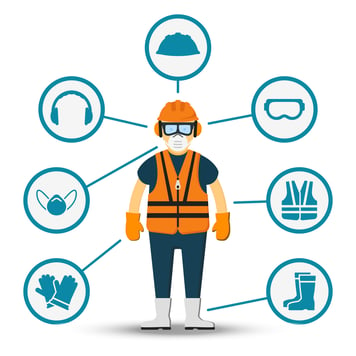All PPE should be safely designed, constructed, and maintained for the sake of worker safety. Whatever the job site is, the workers should be properly fitted to their safety gear. We realize there are many applications that need PPE, so we have thousands of safety gear options to choose from within these categories:

PPE should fit the worker comfortably, encouraging use. If it does not, it can make a huge difference between being safely covered or dangerously exposed. OSHA states, "OSHA requires that many categories of personal protective equipment meet or be equivalent to standards developed by the American National Standards Institute (ANSI)."
Employers are also required to train each worker that uses the PPE to know:
- When the PPE is necessary
- What kind of PPE is necessary for the type of application
- How to properly put on PPE, adjust, wear and take off
- The limitations of the PPE
- Proper care, maintenance, useful life, and disposal of the equipment
First, let's discuss Eye Protection. Thousands of people are blinded each year from work-related eye injuries... and yes, most could have been prevented with the proper selection and use of eye and face protection - "OSHA requires employers to ensure the safety of all employees in the work environment. Eye and face protection must be provided whenever necessary to protect against chemical, environmental, radiological or mechanical irritants and hazards."
Ritz Safety carries Clear Safety Glasses, Safety Sunglasses, Tinted Safety Glasses, Sealed Safety Glasses, LED Safety Glasses, Over-The-Glasses Eyewear, Prescription & Readers Eyewear, Safety Goggles, Safety Goggle Face Shield Combo, and other Eyewear Accessories. We also carry Head and Face Protection.
Another PPE category that is extremely important is Fall Protection. Falls are among the most common causes of serious work related injuries and fatalities. Employers need to set up the work place to prevent employees from falling off of overhead platforms, elevated work stations or into holes in the floor and walls. OSHA requires "fall protection be provided at elevations of four feet in general industry workplaces, five feet in shipyards, six feet in the construction industry and eight feet in longshoring operations. In addition, OSHA requires that fall protection be provided when working over dangerous equipment and machinery, regardless of the fall distance."
Whether it is Respiratory Protection, Job Site Protection, Gas Detection, Traffic Safety, Facility Safety, or others - you must be wearing PPE that is ideal for the job and its hazards.

Not sure what the correct PPE for your job application? Contact us today and we will help - wecare@ritzsafety.com